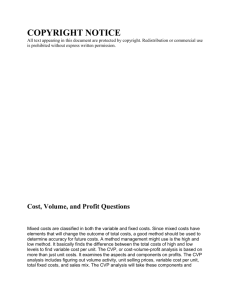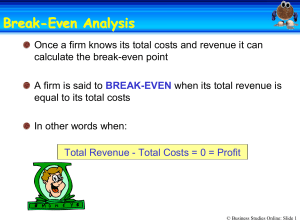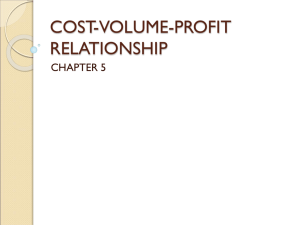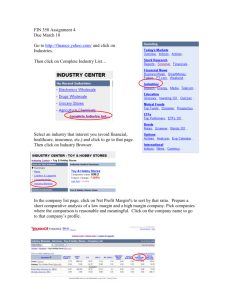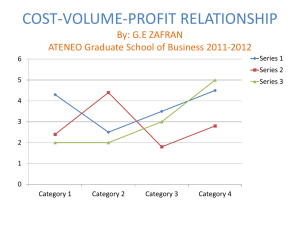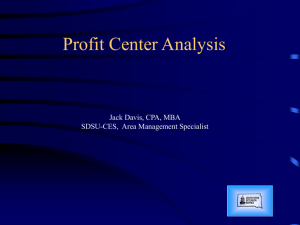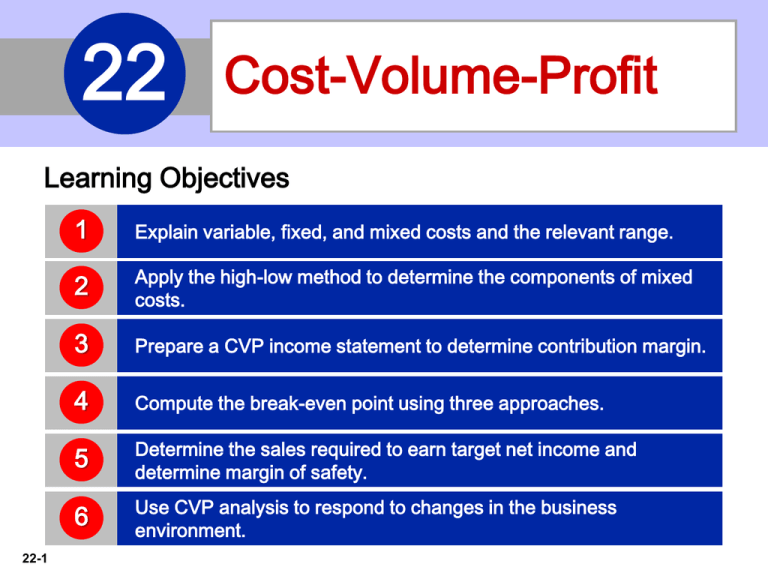
22
Cost-Volume-Profit
Learning Objectives
22-1
1
Explain variable, fixed, and mixed costs and the relevant range.
2
Apply the high-low method to determine the components of mixed
costs.
3
Prepare a CVP income statement to determine contribution margin.
4
Compute the break-even point using three approaches.
5
Determine the sales required to earn target net income and
determine margin of safety.
6
Use CVP analysis to respond to changes in the business
environment.
LEARNING
OBJECTIVE
1
Explain variable, fixed, and mixed costs and the
relevant range.
Cost Behavior Analysis is the study of how specific costs
respond to changes in the level of business activity.
22-2
Some costs change; others remain the same.
Helps management plan operations and decide between
alternative courses of action.
Applies to all types of businesses and entities.
Starting point is measuring key business activities.
LO 1
Cost Behavior Analysis
Cost Behavior Analysis is the study of how specific costs
respond to changes in the level of business activity.
22-3
Activity levels may be expressed in terms of:
►
Sales dollars (in a retail company)
►
Miles driven (in a trucking company)
►
Room occupancy (in a hotel)
►
Dance classes taught (by a dance studio)
Many companies use more than one measurement base.
LO 1
Cost Behavior Analysis
Cost Behavior Analysis is the study of how specific costs
respond to changes in the level of business activity.
Changes in the level or volume of activity should be
correlated with changes in costs.
Activity level selected is called activity or volume index.
Activity index:
22-4
Identifies the activity that causes changes in the behavior
of costs.
Allows costs to be classified as variable, fixed, or mixed.
LO 1
Variable Costs
22-5
Costs that vary in total directly and proportionately with
changes in the activity level.
►
Example: If the activity level increases 10 percent,
total variable costs increase 10 percent.
►
Example: If the activity level decreases by 25 percent,
total variable costs decrease by 25 percent.
Variable costs remain the same per unit at every level of
activity.
LO 1
Variable Costs
Illustration: Damon Company manufactures tablet computers that
contain a $10 camera. The activity index is the number of tablets
produced. As Damon manufactures each
Illustration 22-1
tablet, the total cost of the cameras used
increases by $10. As part (a) of
Illustration 22-1 shows, total cost of the
cameras will be $20,000 if Damon
produces 2,000 tablets, and $100,000
when it produces 10,000 tablets. We
also can see that a variable cost remains
the same per unit as the level of activity
changes.
22-6
LO 1
Variable Costs
Illustration: Damon Company manufactures tablet computers that
contain a $10 camera. The activity index is the number of tablets
produced. As Damon manufactures each
Illustration 22-1
tablet, the total cost of the cameras used
increases by $10. As part (b) of
Illustration 22-1 shows, the unit cost of
$10 for the camera is the same whether
Damon produces 2,000 or 10,000
tablets.
22-7
LO 1
Variable Costs
Illustration 22-1
Behavior of total and
unit variable costs
22-8
LO 1
Variable Costs
Question
Variable costs are costs that:
22-9
a.
Vary in total directly and proportionately with changes
in the activity level.
b.
Remain the same per unit at every activity level.
c.
Neither of the above.
d.
Both (a) and (b) above.
LO 1
Fixed Costs
22-10
Costs that remain the same in total regardless of
changes in the activity level within a relevant range.
Fixed cost per unit cost varies inversely with activity:
As volume increases, unit cost declines, and vice versa
Examples:
►
Property taxes
►
Insurance
►
Rent
►
Depreciation on buildings and equipment
LO 1
Fixed Costs
Illustration: Damon Company leases its productive facilities at a cost
of $10,000 per month. Total fixed costs of the facilities will remain
constant at every level of activity, as part
Illustration 22-2
(a) of Illustration 22-2 shows.
22-11
LO 1
Fixed Costs
Illustration: Damon Company leases its productive facilities at a cost
of $10,000 per month. Total fixed costs of the facilities will remain
constant at every level of activity. But,
Illustration 22-2
on a per unit basis, the cost of rent will
decline as activity increases, as part (b)
of Illustration 22-2 shows. At 2,000 units,
the unit cost per tablet computer is $5
($10,000 ÷ 2,000). When Damon
produces 10,000 tablets, the unit cost of
the rent is only $1 per tablet ($10,000 ÷
10,000).
22-12
LO 1
Fixed Costs
Illustration 22-2
Behavior of total and
unit fixed costs
22-13
LO 1
People, Planet, and Profit Insight
Gardens in the Sky
Because of population increases, the United Nations’ Food and Agriculture Organization
estimates that food production will need to increase by 70% by 2050. Also, by 2050,
roughly 70% of people will live in cities, which means more food needs to be hauled
further to get it to the consumer. To address the lack of farmable land and reduce the cost
of transporting produce, some companies, such as New York-based Bright Farms, are
building urban greenhouses. This sounds great, but do the numbers work? Some variable
costs would be reduced. For example, the use of pesticides, herbicides, fuel costs for
shipping, and water would all drop. Soil erosion would be a non-issue since plants would
be grown hydroponically (in a solution of water and minerals), and land requirements
would be reduced because of vertical structures. But, other costs would be higher. First,
there is the cost of the building. Also, any multistory building would require artificial lighting
for plants on lower floors. Until these cost challenges can be overcome, it appears that
these urban greenhouses may not break even. On the other hand, rooftop greenhouses
on existing city structures already appear financially viable. For example, a 15,000 squarefoot rooftop greenhouse in Brooklyn already produces roughly 30 tons of vegetables per
year for local residents.
Sources: “Vertical Farming: Does It Really Stack Up?” The Economist (December 9, 2010); and Jane
Black, “Bright Farms Idea: Greenhouses That Cut Short the Path from Plant to Grocery Shelf,” The
Washington Post (May 7, 2013).
22-14
LO 1
Relevant Range
22-15
Throughout the range of possible levels of activity, a
straight-line relationship usually does not exist for either
variable costs or fixed costs.
Relationship between variable costs and changes in
activity level is often curvilinear.
For fixed costs, the relationship
is also nonlinear – some fixed
costs will not change over the
entire range of activities, while
other fixed costs may change.
LO 1
Relevant Range
Illustration 22-3
Nonlinear behavior of
variable and fixed costs
22-16
LO 1
Relevant Range
Range of activity over which a company expects to
operate during a year.
22-17
Illustration 22-4
Linear behavior within
relevant range
LO 1
Relevant Range
Question
The relevant range is:
a. The range of activity in which variable costs will be
curvilinear.
b. The range of activity in which fixed costs will be
curvilinear.
c. The range over which the company expects to operate
during a year.
d. Usually from zero to 100% of operating capacity.
22-18
LO 1
Mixed Costs
Costs that have both a variable element and a fixed
element.
Change in total but not proportionately with changes in
activity level.
Illustration 22-5
Behavior of a mixed cost
22-19
LO 1
DO IT! 1
Type of Costs
Helena Company, reports the following total costs at two levels
of production.
Classify each cost as variable, fixed, or mixed.
Variable
Fixed
Mixed
22-20
LO 1
LEARNING
OBJECTIVE
2
Apply the high-low method to determine the
components of mixed costs.
High-Low Method
22-21
High-Low Method uses the total costs incurred at the high
and the low levels of activity to classify mixed costs into
fixed and variable components.
The difference in costs between the high and low levels
represents variable costs, since only variable-cost element
can change as activity levels change.
LO 2
High-Low Method
STEP 1: Determine variable cost per unit using the following
formula:
Illustration 22-6
Formula for variable cost per
unit using high-low method
22-22
LO 2
High-Low Method
Illustration: Metro Transit Company has the
following maintenance costs and mileage data for
its fleet of buses over a 6-month period.
Change in Costs (63,000 - 30,000)
High minus Low
22-23
(50,000 - 20,000)
$33,000
30,000
Illustration 22-7
Assumed maintenance
costs and mileage data
= $1.10
cost per
unit
LO 2
High-Low Method
STEP 2: Determine the fixed cost by subtracting
the total variable cost at either the high or the low
activity level from the total cost at that activity level.
22-24
Illustration 22-8
High-low method
computation of
fixed costs
LO 2
High-Low Method
Maintenance costs are therefore $8,000 per month of fixed costs
plus $1.10 per mile of variable costs. This is represented by the
following formula:
Maintenance costs = $8,000 + ($1.10 x Miles driven)
Example: At 45,000 miles, estimated maintenance costs would
be:
Fixed
$ 8,000
Variable
($1.10 x 45,000)
49,500
$57,500
22-25
LO 2
High-Low Method
Illustration 22-9
Scatter plot for Metro
Transit Company
22-26
LO 2
High-Low Method
Question
Mixed costs consist of a:
a. Variable cost element and a fixed cost element.
b. Fixed cost element and a controllable cost element.
c. Relevant cost element and a controllable cost
element.
d. Variable cost element and a relevant cost element.
22-27
LO 2
Management Insight
Temper Sealy International
Skilled Labor Is Truly Essential
The recent recession had devastating implications for employment. But one
surprise was that for some manufacturers, the number of jobs lost was
actually lower than in previous recessions. One of the main explanations for
this was that in the years preceding the recession, many companies, such
as Tempur Sealy International, adopted lean manufacturing practices. This
meant that production relied less on large numbers of low-skilled workers
and more on machines and a few highly skilled workers. As a result of this
approach, a single employee supports far more dollars in sales. Thus, it
requires a larger decline in sales before an employee would need to be
laid-off in order for the company to continue to break even. Also, because
the employees are highly skilled, employers are reluctant to lose them.
Instead of lay-offs, many manufacturers now resort to cutting employees’
hours when necessary.
Source: Timothy Aeppel and Justin Lahart, “Lean Factories Find It Hard to Cut Jobs
Even in a Slump,” Wall Street Journal Online (March 9, 2009).
LO 2
22-28
DO IT! 2
High-Low Method
Byrnes Company accumulates the following data concerning a mixed
cost, using units produced as the activity level.
(a) Compute the variable- and fixed-cost elements using the high-low
method.
(b) Estimate the total cost if the company produces 8,000 units.
22-29
LO 2
DO IT! 2
High-Low Method
(a) Compute the variable and fixed cost elements using the high-low
method.
Variable cost: ($14,740 - $11,100) / (9,800 - 7,000) = $1.30 per unit
Fixed cost: $14,740 - $12,740 ($1.30 x 9,800 units) = $2,000
or $11,100 - $9,100 ($1.30 x 7,000) = $2,000
22-30
LO 2
DO IT! 2
High-Low Method
(b) Estimate the total cost if the company produces 8,000 units.
Total cost (8,000 units): $2,000 + $10,400 ($1.30 x 8,000) = $12,400
22-31
LO 2
LEARNING
OBJECTIVE
3
Prepare a CVP income statement to determine
contribution margin.
Cost-volume-profit (CVP) analysis is the study of the effects
of changes in costs and volume on a company’s profits.
22-32
Important in profit planning.
Critical factor in management decisions as
►
Setting selling prices,
►
Determining product mix, and
►
Maximizing use of production facilities.
LO 3
Cost-Volume-Profit Analysis
Basic Components
Illustration 22-10
Components of CVP analysis
22-33
LO 3
Basic Components
Assumptions
22-34
Behavior of both costs and revenues is linear throughout
the relevant range of the activity index.
Costs can be classified accurately as either variable or
fixed.
Changes in activity are the only factors that affect costs.
All units produced are sold.
When more than one type of product is sold, the sales mix
will remain constant.
LO 3
Basic Components
Question
Which of the following is not involved in CVP analysis?
a. Sales mix.
b. Unit selling prices.
c. Fixed costs per unit.
d. Volume or level of activity.
22-35
LO 3
Cost-Volume-Profit Analysis
CVP Income Statement
A statement for internal use.
Classifies costs and expenses as fixed or variable.
Reports contribution margin in the body of the
statement.
►
22-36
Contribution margin – amount of revenue remaining
after deducting variable costs.
Reports the same net income as a traditional income
statement.
LO 3
CVP Income Statement
Illustration: Vargo Video Company produces a high-definition
digital camcorder. Relevant data for the camcorders sold by
this company in June 2014 are as follows.
Illustration 22-11
Assumed selling and cost data
for Vargo Video
22-37
LO 3
CVP Income Statement
Illustration: The CVP income statement for Vargo Video
therefore would be reported as follows.
Illustration 22-12
22-38
LO 3
CVP Income Statement
UNIT CONTRIBUTION MARGIN
Contribution margin is available to cover fixed costs
and to contribute to income.
Formula for contribution margin per unit and the
computation for Vargo Video are:
Illustration 22-13
Formula for unit contribution margin
22-39
LO 3
CVP Income Statement
UNIT CONTRIBUTION MARGIN
Vargo’s CVP income statement assuming a zero net income.
Illustration 22-14
22-40
LO 3
CVP Income Statement
UNIT CONTRIBUTION MARGIN
Assume that Vargo sold one more camcorder, for a total of
1,001 camcorders sold.
Illustration 22-15
22-41
LO 3
CVP Income Statement
CONTRIBUTION MARGIN RATIO
Shows the percentage of each sales dollar available
to apply toward fixed costs and profits.
Formula for contribution margin ratio and the
computation for Vargo Video are:
Illustration 22-17
Formula for contribution
margin ratio
22-42
LO 3
CVP Income Statement
CONTRIBUTION MARGIN RATIO
Illustration 22-16
CVP income statement, with
net income and percent of sales data
22-43
LO 3
CVP Income Statement
CONTRIBUTION MARGIN RATIO
Assume Vargo Video’s current sales are $500,000 and it wants
to know the effect of a $100,000 (200-unit) increase in sales.
Illustration 22-18
22-44
LO 3
CVP Income Statement
Question
Contribution margin:
a. Is revenue remaining after deducting variable costs.
b. May be expressed as contribution margin per unit.
c. Is selling price less cost of goods sold.
d. Both (a) and (b) above.
22-45
LO 3
DO IT! 3
CVP Income Statement
Ampco Industries produces and sells a cell phone-operated
thermostat. Information regarding the costs and sales of
thermostats during September 2017 are provided below.
Unit selling price of thermostat
$85
Unit variable costs
$32
Total monthly fixed costs
$190,000
Units sold
4,000
Prepare a CVP income statement for Ampco Industries for the
month of September. Provide per unit values and total values.
22-46
LO 3
DO IT! 3
CVP Income Statement
Prepare a CVP income statement for Ampco Industries for the
month of September. Provide per unit values and total values.
22-47
LO 3
LEARNING
OBJECTIVE
4
Compute the break-even point using three
approaches.
Break-Even Analysis
Process of finding the break-even point level of activity at
which total revenues equal total costs (both fixed and
variable).
Can be computed or derived
22-48
►
from a mathematical equation,
►
by using contribution margin, or
►
from a cost-volume profit (CVP) graph.
Expressed either in sales units or in sales dollars.
LO 4
Mathematical Equation
Break-even occurs where total sales equal variable costs plus
fixed costs; i.e., net income is zero
Computation
of breakeven point in
units.
Illustration 22-20
22-49
LO 4
Contribution Margin Technique
At the break-even point, contribution margin must equal total
fixed costs
(CM = total revenues – variable costs)
22-50
Break-even point can be computed using either contribution
margin per unit or contribution margin ratio.
LO 4
Contribution Margin Technique
CONTRIBUTION MARGIN IN UNITS
When the break-even-point in units is desired,
contribution margin per unit is used in the following
formula which shows the computation for Vargo Video:
Illustration 22-21
Formula for break-even point
in units using unit contribution
margin
22-51
LO 4
Contribution Margin Technique
CONTRIBUTION MARGIN RATIO
When the break-even-point in dollars is desired,
contribution margin ratio is used in the following formula
which shows the computation for Vargo Video:
Illustration 22-22
Formula for break-even point
in dollars using contribution
Margin ratio
22-52
LO 4
Service Company Insight
Flightserve
Charter Flights Offer a Good Deal
The Internet is wringing inefficiencies out of nearly every industry.
While commercial aircraft spend roughly 4,000 hours a year in the
air, chartered aircraft are flown only 500 hours annually. That means
that they are sitting on the ground—not making any money—about
90% of the time. One company, Flightserve, saw a business
opportunity in that fact. For about the same cost as a first-class
ticket, Flightserve matches up executives with charter flights in small
“private jets.” The executive gets a more comfortable ride and avoids
the hassle of big airports. Flightserve noted that the average charter
jet has eight seats. When all eight seats are full, the company has an
80% profit margin. It breaks even at an average of 3.3 full seats per
flight.
Source: “Jet Set Go,” The Economist (March 18, 2000), p. 68.
22-53
LO 4
Graphic Presentation
Because this
graph also shows
costs, volume, and
profits, it is
referred to as a
cost-volume-profit
(CVP) graph.
Illustration 22-23
CVP graph
22-54
LO 4
Break-Even Analysis
Question
Gossen Company is planning to sell 200,000 pliers for $4
per unit. The contribution margin ratio is 25%. If Gossen
will break even at this level of sales, what are the fixed
costs?
a. $100,000.
b. $160,000.
c. $200,000.
d. $300,000.
22-55
LO 4
DO IT! 4
Break-Even Analysis
Lombardi Company has a unit selling price of $400, variable
costs per unit of $240, and fixed costs of $180,000. Compute
the break-even point in units using (a) a mathematical equation
and (b) contribution margin per unit.
22-56
Sales
-
Variable
Costs
-
Fixed
Costs
=
$400Q
-
$240Q
-
$180,000
=
$160Q
-
$180,000
Q
=
1,125 units
Net
Income
0
LO 4
DO IT! 4
Break-Even Analysis
Lombardi Company has a unit selling price of $400, variable
costs per unit of $240, and fixed costs of $180,000. Compute
the break-even point in units using (a) a mathematical equation
and (b) contribution margin per unit.
Fixed
Costs
$180,000
22-57
÷
÷
Contribution
Margin per Unit
=
Break-Even
Point in Units
$160
=
1,125 units
LO 4
LEARNING
OBJECTIVE
5
Determine the sales required to earn target net
income and determine margin of safety.
Target Net Income
Level of sales necessary to achieve a specified income.
Can be determined from each of the approaches used to
determine break-even sales/units:
22-58
►
from a mathematical equation,
►
by using contribution margin technique, or
►
from a cost-volume profit (CVP) graph.
Expressed either in sales units or in sales dollars.
LO 5
Target Net Income
MATHEMATICAL EQUATION
Formula for required sales to meet target net income.
Illustration 22-24
22-59
LO 5
Target Net Income
MATHEMATICAL EQUATION
Using the formula for the break-even point, simply include the
desired net income as a factor.
Illustration 22-25
22-60
LO 5
Target Net Income
CONTRIBUTION MARGIN TECHNIQUE
To determine the required sales in units for Vargo Video:
Illustration 22-26
Formula for required sales in
units using unit contribution
margin
22-61
LO 5
Target Net Income
CONTRIBUTION MARGIN TECHNIQUE
To determine the required sales in dollars for Vargo Video:
Illustration 22-27
Formula for required sales
in dollars using contribution
margin ratio
22-62
LO 5
Target Net Income
GRAPHIC
PRESENTATION
Suppose Vargo Video
sells 1,400 camcorders.
Illustration 22-23 shows
that a vertical line drawn
at 1,400 units intersects
the sales line at $700,000
and the total cost line at
$620,000. The difference
between the two amounts
represents the net
income (profit) of
$80,000.
Illustration 22-23
22-63
LO 5
Target Net Income
Question
The mathematical equation for computing required sales to
obtain target net income is:
Required sales =
a. Variable costs + Target net income.
b. Variable costs + Fixed costs + Target net income.
c. Fixed costs + Target net income.
d. No correct answer is given.
22-64
LO 5
Margin of Safety
Difference between actual or expected sales and sales at
the break-even point.
Measures the “cushion” that a particular level of sales
provides.
May be expressed in dollars or as a ratio.
Assuming actual/expected sales are $750,000:
Illustration 22-28
Formula for margin of safety
in dollars
22-65
LO 5
Margin of Safety
Computed by dividing the margin of safety in dollars by
the actual (or expected) sales.
Assuming actual/expected sales are $750,000:
Illustration 22-29
22-66
The higher the dollars or percentage, the greater the
margin of safety.
LO 5
Margin of Safety
Question
Marshall Company had actual sales of $600,000 when breakeven sales were $420,000. What is the margin of safety ratio?
a. 25%.
b. 30%.
c. 33 1/3%.
d. 45%.
22-67
LO 5
Service Company Insight
Rolling Stones
How a Rolling Stones’ Tour Makes Money
Computations of break-even and margin of safety are important for
service companies. Consider how the promoter for the Rolling
Stones’ tour used the break-even point and margin of safety. For
example, say one outdoor show should bring 70,000 individuals for a
gross of $2.45 million. The promoter guarantees $1.2 million to the
Rolling Stones. In addition, 20% of gross goes to the stadium in
which the performance is staged. Add another$400,000 for other
expenses such as ticket takers, parking attendants, advertising, and
so on. The promoter also shares in sales of T-shirts and memorabilia
for which the promoter will net over $7 million during the tour. From a
successful Rolling Stones’ tour, the promoter could make $35
million!
22-68
LO 5
Break-Even, Margin of
Comprehensive
Safety, and Target Net Income
DO IT! 5
Zootsuit Inc. makes travel bags that sell for $56 each. For the
coming year, management expects fixed costs to total
$320,000 and variable costs to be $42 per unit. Compute the
following:
a) break-even point in dollars using the contribution margin
(CM) ratio;
b) the margin of safety and margin of safety ratio assuming
actual sales are $1,382,400; and
c) the sales dollars required to earn net income of
$410,000.
22-69
LO 5
DO IT! 5
Break-Even, Margin of
Safety, and Target Net Income
Zootsuit Inc. makes travel bags that sell for $56 each. For the
coming year, management expects fixed costs to total
$320,000 and variable costs to be $42 per unit. Compute
break-even point in dollars using the contribution margin (CM)
ratio.
Contribution margin ratio = [($56 - $42) ÷ $56] = 25%
Break-even sales in dollars = $320,000 ÷ 25% = $1,280,000
22-70
LO 5
DO IT! 5
Break-Even, Margin of
Safety, and Target Net Income
Zootsuit Inc. makes travel bags that sell for $56 each. For the
coming year, management expects fixed costs to total
$320,000 and variable costs to be $42 per unit. Compute the
margin of safety and margin of safety ratio assuming actual
sales are $1,382,400.
Margin of safety = $1,382,400 - $1,280,000 = $102,400
Margin of safety ratio = $102,400 ÷ $1,382,400 = 7.4%
22-71
LO 5
DO IT! 5
Break-Even, Margin of
Safety, and Target Net Income
Zootsuit Inc. makes travel bags that sell for $56 each. For the
coming year, management expects fixed costs to total
$320,000 and variable costs to be $42 per unit. Compute the
sales dollars required to earn net income of $410,000.
Required sales in dollars =
($320,000 + $410,000) ÷ 25% = $2,920,000
22-72
LO 5
LEARNING
OBJECTIVE
6
Use CVP analysis to respond to changes in
the business environment.
Illustration: Three independent situations that might occur at
Vargo Video. Each case uses the original camcorder sales and
cost data, which were as follows.
Illustration 22-30
Original camcorder sales
and cost data
22-73
LO 6
Case I: Offering a Discount
A competitor is offering a 10% discount on the selling price of its
camcorders. Management must decide whether to offer a similar
discount.
Question: What effect will a 10% discount on selling price ($500 x
10% = $50) have on the breakeven point?
Fixed Costs
÷
Unit Contribution
Margin
$200,000
÷
$150
Illustration 22-31
Computation of break-even
sales in units
22-74
= Break-Even Sales
=
1,333 units
(rounded)
LO 6
Case II: Investing in New Equipment
Management invests in new robotic equipment that will lower the
amount of direct labor required to make camcorders. Estimates are
that total fixed costs will increase 30% and that variable cost per
unit will decrease 30%.
Question: What effect will the new equipment have on the sales
volume required to break even?
Fixed Costs
÷
Unit Contribution
Margin
$260,000
÷
($500 - $210)
Illustration 22-32
Computation of break-even
sales in units
22-75
= Break-Even Sales
=
897 units
(rounded)
LO 6
Case III: Determining Required Sales
Vargo’s principal supplier of raw materials has just announced a
price increase. The higher cost is expected to increase the variable
cost of camcorders by $25 per unit. Management decides to hold
the line on the selling price of the camcorders. It plans a costcutting program that will save $17,500 in fixed costs per month.
Vargo is currently realizing monthly net income of $80,000 on sales
of 1,400 camcorders.
Question: What increase in units sold will be needed to maintain
the same level of net income?
22-76
LO 6
Case III: Determining Required Sales
Variable cost per unit increases to $325 ($300 + $25).
Fixed costs are reduced to $182,500 ($200,000 - $17,500).
Contribution margin per unit becomes $175 ($500 - $325).
(Fixed Cost + Target
Net Income)
-
Unit Contribution
Margin
($182,500 + $80,000)
-
$175
Required Sales in
=
Units
=
1,500
Illustration 22-33
Computation of required sales
22-77
LO 6
Basic Concepts
Question
Croc Catchers calculates its contribution margin to be less
than zero. Which statement is true?
a. Its fixed costs are less than the variable cost per unit.
b. Its profits are greater than its total costs.
c. The company should sell more units.
d. Its selling price is less than its variable costs.
22-78
LO 6
Management Insight
Amazon.com
Don’t Just Look—Buy Something
When analyzing an Internet business such as Amazon. com, analysts closely
watch the so-called “conversion rate.” This rate is calculated by dividing the
number of people who actually take action at an Internet site (buy something) by
the total number of people who visit the site. Average conversion rates are from
3% to 5%. A rate below 2% is poor, while a rate above 10% is great. Conversion
rates have an obvious effect on the breakeven point. Suppose you spend
$10,000 on your site, which then attracts 5,000 visitors. If you get a 2%
conversion rate (100 purchases), your site costs $100 per purchase ($10,000 ÷
100). A 4% conversion rate lowers your cost to $50 per transaction, and an 8%
conversion rate gets you down to $25. Studies show that conversion rates
increase if the site has an easy-to-use interface, fast-performing screens, a
convenient ordering process, and advertising that is both clever and clear.
Sources: J. William Gurley, “The One Internet Metric That Really Counts” Fortune (March
6, 2000), p. 392; and Milind Mody, “Chief Mentor: How Startups Can Win Customers
Online,” Wall Street Journal Online, (May 11, 2011).
22-79
LO 6
CVP Income Statement Revisited
Assume that Vargo Video reaches its target net income of
$120,000. The following information is obtained on the $680,000
of costs that were incurred in June to produce and sell 1,600
units.
Illustration 22-34
Assumed cost and
expense data
22-80
LO 6
Illustration 22-35
Detailed CVP income statement
22-81
LO 6
DO IT! 6
CVP Analysis
Krisanne Company reports the following operating results for the month of June
2017.
To increase net income, management is considering reducing the selling price
by 10%, with no changes to unit variable costs or fixed costs. Management is
confident that this change will increase unit sales by 25%. Using the contribution
margin technique, compute the break-even point in units and dollars and margin
of safety in dollars (a) assuming no changes to sales price or costs, and (b)
assuming changes to sales price and volume as described above. (c) Comment
on your findings.
22-82
LO 6
DO IT! 6
CVP Analysis
Krisanne Company reports the following operating results for the month of June
2017.
22-83
LO 6
DO IT! 6
CVP Analysis
Krisanne Company reports the following operating results for the month of June
2017.
22-84
LO 6
DO IT! 6
CVP Analysis
Krisanne Company reports the following operating results for the month of June
2017.
(c) The increase in the break-even point and the decrease in the margin of
safety indicate that management should not implement the proposed
change. The increase in sales volume will result in contribution margin of
$112,500 (6,250 x $18), which is $7,500 less than the current amount.
22-85
LO 6
LEARNING
OBJECTIVE
7
APPENDIX 22A: Explain the difference between
absorption costing and variable costing.
Under variable costing only direct materials, direct labor, and
variable manufacturing overhead costs are considered product
costs. Companies recognize fixed manufacturing overhead
costs as period costs (expenses) when incurred.
Illustration 22A-1
Difference between absorption
costing and variable costing
22-86
LO 7
CVP Income Statement Revisited
Illustration: Assume that Premium Products Corporation
manufactures a polyurethane sealant, called Fix-It, for car
windshields. Relevant data for Fix-It in January 2017, the first
month of production, are as follows.
Illustration 22A-2
Sealant sales and cost data for
Premium Products Corporation
22-87
LO 7
CVP Income Statement Revisited
Illustration: The per unit production cost of Fix-It
Illustration 22A-3
Computation of per unit
manufacturing cost
under each costing approach is:
*
Based on these data, each unit sold and each unit remaining in
inventory is costed under absorption costing at $13 and under variable
costing at $9.
22-88
LO 7
Illustration 22A-4
Absorption costing
income statement
22-89
Helpful Hint
The income statement format in Illustration 22A-4
is the same as that used under generally accepted
accounting principles.
LO 7
Illustration 22A-5
Variable costing
income statement
22-90
Helpful Hint
Note the difference in the computation of the ending inventory:
$9 per unit here, $13 per unit in Illustration 22A-4.
LO 7
Absorption and Variable Costing
Illustration 22A-6
Summary of income effects under absorption
costing and variable costing
22-91
LO 7
Rationale for Variable Costing
22-92
The purpose of fixed manufacturing costs is to have
productive facilities available for use.
The use of variable costing is acceptable only for internal
use by management.
LO 7
Copyright
“Copyright © 2015 John Wiley & Sons, Inc. All rights reserved.
Reproduction or translation of this work beyond that permitted in
Section 117 of the 1976 United States Copyright Act without the
express written permission of the copyright owner is unlawful. Request
for further information should be addressed to the Permissions
Department, John Wiley & Sons, Inc. The purchaser may make backup copies for his/her own use only and not for distribution or resale.
The Publisher assumes no responsibility for errors, omissions, or
damages, caused by the use of these programs or from the use of the
information contained herein.”
22-93

